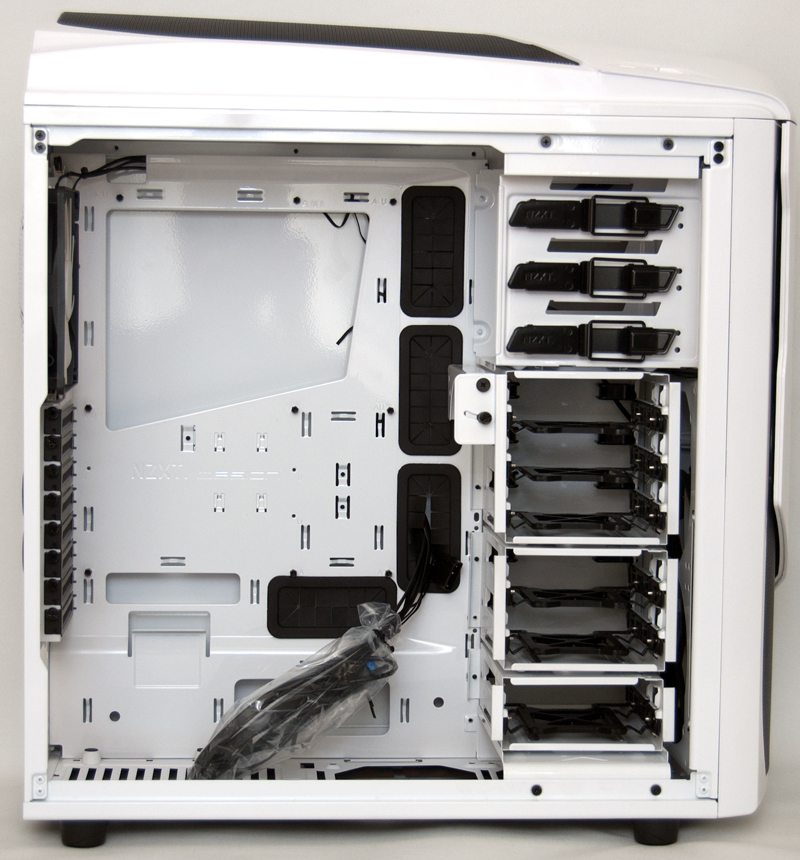NZXT Phantom 530 Chassis Review
Inside the chassis we see the usual NZXT flair, a high quality interior paint job, large CPU cooler cut-out, high quality cable management cut-outs and grommets, black finishings on the screws, panels, drive bays, pretty much what we have come to expect from high end NZXT chassis designs and clearly targeted toward the high-end of the system building market.

In the base of the chassis we find 6 small raisers that provide a little extra clearance for the PSU, but these should also help reduce some vibration from the PSU fan thanks to the rubber tips on the raisers.

The right features three high quality metal snap-lock mechanisms on the 5.25″ drive bays that are as practical as they are stylish. Further down we have one of the hallmarks of a high end NZXT chassis, three fully modular HDD bays laid out in a 3 + 2 + 1 format, each with support for 3.5″ and 2.5″ HDDs. These can be fully removed in any order, allowing room for extra cooling fans, radiators or what ever your case modding mind can think of. There is also a swivel mount for an optional internal 140mm fan that can help direct air towards your GPU(s).

In the rear of the chassis we find a small cut-out at the top of the back plate, perfect for running extra fan and motherboard cables through, a pre-installed 140mm exhaust fan, quick release thumb screws on each of the expansion slot covers.

Around the back we better see the cable management options of the chassis, there are a huge number of large tie down loops that are perfect for pinning your cables in place and this should result in a very tidy final build if you take the time to utilize them.

Another NZXT feature I’ve always liked is an extra 2.5″ drive mount on the rear of the motherboard area, this allows you to stealth mount a drive, handy if you’ve stripped out all the HDD bays to make way for a huge radiator. Also you will find a 10 port fan controller hub for the three speed controller on the front panel, ensuring you have more than enough connections for all your cooling fans.

The rear of the chassis offers up an inch of space, which is more than enough for most any system build and you shouldn’t have any issues with getting the side panel back in place after you’ve installed all your components.










It’s a super mid sized chassis. I like the fact they’ve lost the USB 2 ports. What still mystifies me is the inclusion of grommeted holes for water tubing on the back, I mean, have you ever seen anyone use them?… but that’s really a non-issue. Hopefully they’ll release the case in a whole host of colours as time passes but I do like the red. I’m so tired of back or white cases that I’m starting to miss the days of the beige box. Lol.
I’ve seen lots of people using those holes. I just don’t understand why anyone would want to. Externally mounted (or unmounted) systems are not very elegant or practical.
i have never seen anyone who does…did you take pictures of the great white buffalo?
Yes, I think this case is a super mid sized chassis too, I’m looking for a true full tower, one that can accommodate a pair of 480 or 420 radiators and a power supply of any length, so far I know of only that could fit the bill, but so far Phanteks has not started selling them yet, latest word on Enthoo Primo is September or October, I can wait, but not forever, if NZXT made a stretched version of the 530 that could fill this requirement and not be made of aluminum or cost more than $250.00(US$), I could see Myself buying 2 cases, otherwise I can wait.
they do…check out the 630 model…it’s below $200 and it is a pretty big case.
According to the specs this case is made of plastic and steel.
No beige boxes! LoL. Never again!
can’t believe the reviewer didn’t point out the differences between this case and the 630.
I love it but I need more than three drive bays in front. Four would be the minimum for me. One DVD, room for a more versatile fan controller and a memory slot reader.
Fan controller is in the case
USB 2.0 ports are so obsolete. Glad they are gone. I’m leaning towards either the Phantom 530 or the Storm Stryker when I build my new PC (after GTX780Ti comes out of course!)
is FZ-200 or FS-200mm will sit perfectly on top of this chassis?